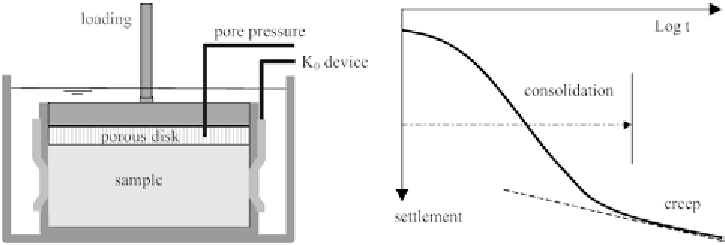Geoscience Reference
In-Depth Information
Intensive monitoring of the strength and performance reduces costly over-
dimensioning, enables transparent and reproducible decision-making during
imminent calamities, enables determination of the effectiveness of innovative
construction technologies, and plays an eminent role in the observational method
(Eurocode 7).
B
LABORATORY TESTING
For most standard laboratory tests in geotechnical practice internationally
accepted test procedures are available. These laboratory tests are suitable to
determine the following
- soil classification (already discussed before);
- permeability (constant head test, falling head test);
- compressibility and creep (oedometer, swelling test);
- strength properties (shearbox, triaxial test);
- compaction (density tests);
- chemical constitution tests.
Permeability
For granular soils the constant head method is applied for determining the
sample permeability
k
(see Fig 4.2). For cohesive less-permeable soils the falling
head method is suitable (see Fig 4.3). For this method the applied stress state is
important and consideration of different loading stages is sometimes required (see
also oedometer test). The in-situ permeability of soils, in particularly in sand and
silt formations, is often determined by site investigation (pumping test, piezocone,
monopole sounding).
Figure 3.2 Oedometer with K
0
facility
Oedometer and swelling test
The oedometer is used to determine the uniaxial deformation of a soil sample. It
is particularly suitable to soft and less pervious soils (silt, clay, peat). In principle,
four parameters are determined: consolidation coefficient
c
v
(the
v
refers to
vertical), the coefficient of vertical volume strain
m
v
or the compressibility index
C
c
, the vertical permeability
k
, and the creep index
C
. A variety of testing
equipment and procedures exist. Most commonly, incremental loading is applied,
with the load being doubled each subsequent step (Load Increment Ratio = 1).

Search WWH ::

Custom Search